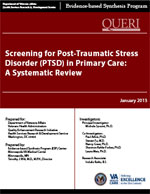
|
Investigators: Principal Investigator: Michele Spoont, Ph.D. Co-Investigators: Paul Arbisi, Ph.D. Steven Fu, M.D. Nancy Greer, Ph.D. Shannon Kehle-Forbes, Ph.D. Laura Meis, Ph.D. Research Associate: Indulis Rutks, B.S. Evidence-based Synthesis Program (ESP) Center
Minneapolis VA Medical Center
Washington (DC): Department of Veterans Affairs; January 2013 |
Download PDF: Complete Report, Executive Summary, Report, Appendices
Evidence suggests that the majority of Americans will experience a traumatic event at some time during their lives and that approximately 8% will subsequently develop post-traumatic stress disorder (PTSD). PTSD is one of the most common psychiatric sequellae of traumatic experiences and is characterized by an intense emotional reaction to the traumatic event, and followed by a persistent re-experiencing of the trauma, avoidance of things associated with the trauma, numbed emotional responsiveness, and increased arousal. Rates among military Veterans returning from deployments in Iraq and Afghanistan are much higher than that found in the general population, as high as 20% by some estimates. Currently, about 400,000 Veterans enrolled in VA carry a PTSD diagnosis.
Those who suffer from PTSD often have diminished functioning and a poorer quality of life as evidenced by elevated rates of suicide, hospital admissions, poverty, and unemployment. Significant medical morbidity is also common among those with PTSD and several agerelated chronic medical conditions develop earlier. Moreover, people with PTSD have higher prevalence rates of problematic health behaviors, and utilize medical care at higher rates than those without PTSD. Although there are PTSD treatments available that have demonstrated effectiveness among individuals with diagnosed PTSD, many people who have PTSD may not be diagnosed and many who are diagnosed do not pursue mental health treatment. Of those who do seek treatment, prolonged delays are common.
To minimize treatment delays and to maximize population reach, VA established a screening program to identify PTSD in their patients as they present in primary care clinics. Such screening programs may be helpful because primary care providers often have difficulty identifying PTSD in their patients and PTSD is therefore frequently undertreated in the primary care setting. The premise of this type of screening program is to identify individuals needing further evaluation so as to facilitate mental health treatment engagement earlier in the course of the illness and to identify patients for treatment who might not otherwise be identified as needing mental health care.
Recently, the Institute of Medicine (IOM) released a report examining the screening, diagnosis, treatment, and rehabilitation services for military Veterans and service members with PTSD in the Department of Veterans Affairs and the Department of Defense. As noted in the IOM report and elsewhere, successful screening programs utilize instruments that are simple, valid, precise, and acceptable both clinically and socially. To identify screening tools that are best suited to primary care practice and to maximize relevance to the VA population, this evidence synthesis report reviews the literature on the feasibility and diagnostic accuracy of screening tools used in a primary care setting in the United States.